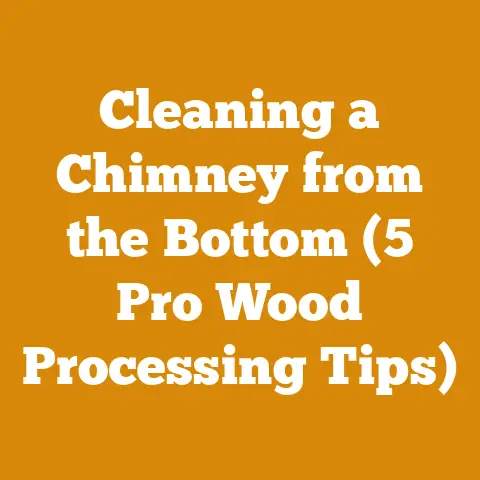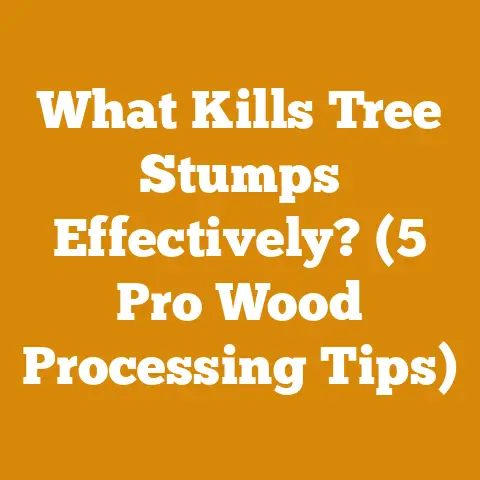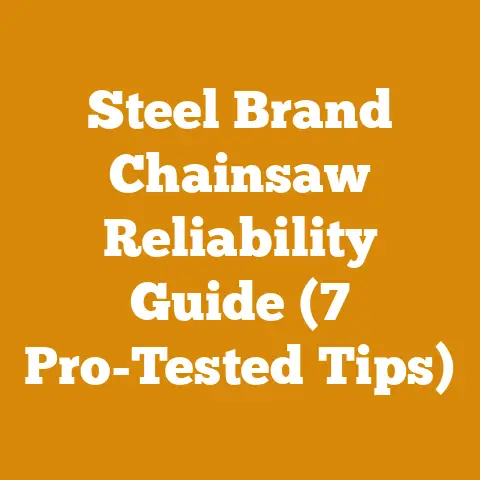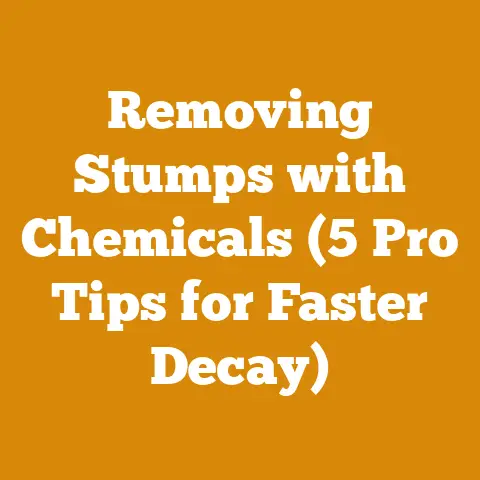Does Tordon Kill Grass? (5 Pro Tips for Safe Woodland Clearing)
Have you ever stood at the edge of your property, gazing at a thicket of unwanted trees and brush, dreaming of a pristine woodland?
I know I have.
The temptation to reach for a powerful herbicide like Tordon can be overwhelming.
But before you do, a crucial question lingers: “Does Tordon kill grass?” The answer isn’t as straightforward as you might think, and the consequences of misapplication can be far-reaching.
I’ve spent years clearing land, managing forests, and prepping firewood, and I’ve seen firsthand the damage that can occur when herbicides are used carelessly.
This guide will walk you through the ins and outs of Tordon, its effects on grass, and, most importantly, how to use it safely and effectively for woodland clearing.
Does Tordon Kill Grass? Understanding the Herbicide’s Impact
Tordon is a powerful herbicide primarily used for controlling unwanted trees and broadleaf weeds.
Its active ingredient, picloram, is highly effective at disrupting plant growth.
Let’s explore this further.
The Science Behind Tordon and Grass
Picloram, the active ingredient in Tordon, works by mimicking plant hormones, specifically auxins.
Auxins regulate plant growth and development.
When picloram enters a plant, it overstimulates these hormone receptors, leading to uncontrolled growth, disruption of nutrient transport, and ultimately, plant death.
Grasses, like broadleaf weeds and trees, possess these hormone receptors.
Therefore, they are susceptible to the effects of picloram.
The degree to which Tordon affects grass depends on several factors:
- Concentration: Higher concentrations will obviously have a more significant impact.
- Application Method: Spraying directly onto grass is far more damaging than a carefully targeted application to tree stumps.
- Grass Species: Some grass species are more tolerant to picloram than others.
- Environmental Conditions: Factors like rainfall can influence how the herbicide spreads and its effectiveness.
My Experience with Tordon and Grass
I recall one particular instance where a client, eager to clear a patch of invasive honeysuckle, inadvertently sprayed Tordon near a well-established patch of fescue.
The result was a clearly defined zone of dead and dying grass, a stark reminder of the herbicide’s potency.
It took several months of reseeding and careful watering to restore the lawn.
This experience cemented my understanding of the need for precision and caution when using Tordon.
Key Takeaway
Yes, Tordon can kill grass.
The extent of the damage depends on various factors, but it’s crucial to understand that grasses are not immune to its effects.
5 Pro Tips for Safe Woodland Clearing with Tordon
Now that we’ve established that Tordon can indeed harm grass, let’s dive into how to use it safely and effectively for woodland clearing, minimizing the risk to desirable vegetation.
1. Precision is Paramount: Targeted Application Techniques
The key to minimizing grass damage is targeted application.
Avoid broadcast spraying at all costs.
Here are a few methods I’ve found successful:
- Cut-Stump Treatment: This involves cutting down the unwanted tree or shrub and immediately applying Tordon to the freshly cut stump.
This method is highly effective because the herbicide is directly absorbed into the root system, preventing regrowth.
I typically use a small paintbrush or a squirt bottle for this.
The goal is to saturate the cambium layer (the area just inside the bark) completely.- Tool List: Chainsaw, hand saw (for smaller saplings), paintbrush or squirt bottle, Tordon herbicide, safety glasses, gloves.
- Measurement: Apply enough herbicide to thoroughly wet the cambium layer, typically 2-4 ml per inch of stump diameter.
- Hack-and-Squirt Method: For larger trees that are difficult to cut down, the hack-and-squirt method is a good option.
Use a hatchet or axe to make downward-angled cuts into the trunk, penetrating the bark and cambium layer.
Then, apply Tordon directly into the cuts.- Tool List: Hatchet or axe, squirt bottle, Tordon herbicide, safety glasses, gloves.
- Measurement: Make cuts every 2-3 inches around the circumference of the tree and apply 1-2 ml of herbicide per cut.
- Foliar Spray (Use with Extreme Caution): While not ideal due to the risk of drift, foliar spraying can be necessary for controlling certain invasive species.
If you must use this method, choose a calm day with minimal wind.
Use a low-pressure sprayer and a nozzle that produces large droplets to reduce drift.
Shield desirable vegetation with cardboard or plastic sheeting.- Tool List: Low-pressure sprayer, appropriate nozzle, Tordon herbicide, safety glasses, gloves, protective sheeting (cardboard or plastic).
- Measurement: Follow the herbicide label instructions for dilution rates.
Avoid over-spraying.
2. Understanding Tordon’s Formulation and Concentration
Tordon comes in various formulations, each with different concentrations of picloram.
Always read the label carefully and understand the concentration you’re working with.
Higher concentrations are more effective but also pose a greater risk to non-target vegetation.
- Example: Tordon RTU (Ready-To-Use) contains a lower concentration of picloram than Tordon 22K.
Therefore, Tordon RTU might be suitable for smaller, more sensitive areas, while Tordon 22K is better suited for larger infestations of tough-to-kill species.
I always keep a detailed log of the Tordon formulation I use, the dilution rate (if applicable), and the date and location of application.
This helps me track the effectiveness of the treatment and avoid accidental over-application.
3. Timing is Everything: Optimizing Application for Minimal Impact
The timing of your Tordon application can significantly impact its effectiveness and minimize harm to grass.
Here are some considerations:
- Avoid Application During Grass Growing Season: Grass is most vulnerable to herbicides when it’s actively growing.
Avoid applying Tordon during the spring and early summer when grass is putting on new growth.
Late summer or fall, when grass growth slows down, is generally a better time. - Consider Tree Physiology: The best time to apply Tordon to trees and shrubs is when they are actively transporting nutrients to their roots.
This typically occurs in the late summer or early fall, before leaf drop.
This allows the herbicide to be effectively translocated throughout the plant, maximizing its effectiveness. - Weather Conditions: Avoid applying Tordon on windy days, as this can lead to drift and unintended damage to desirable vegetation.
Also, avoid application before heavy rain, as the herbicide can be washed away before it has a chance to be absorbed by the target plants.
4. Buffer Zones: Protecting Sensitive Areas
Establishing buffer zones around sensitive areas, such as lawns, gardens, and waterways, is crucial for preventing accidental Tordon exposure.
- Define Your Buffer Zone: Determine the appropriate width of your buffer zone based on the application method and the terrain.
For foliar spraying, a wider buffer zone is necessary than for cut-stump treatment.
I typically use a minimum of 25 feet for foliar spraying and 10 feet for cut-stump treatment. - Mark Your Buffer Zone: Clearly mark your buffer zone with flags, stakes, or tape.
This will help you avoid accidentally spraying in these areas. - Use Physical Barriers: Consider using physical barriers, such as tarps or cardboard, to shield sensitive vegetation during application.
5. Post-Application Monitoring and Remediation
Even with careful application, accidental Tordon exposure can occur.
It’s essential to monitor the treated area after application and take steps to remediate any damage.
- Monitor for Symptoms: Look for signs of herbicide damage in nearby grass, such as yellowing, browning, or stunted growth.
- Remediation: If you notice damage, take the following steps:
- Water Thoroughly: Immediately water the affected area to dilute the herbicide and encourage grass recovery.
- Aerate the Soil: Aerating the soil can help improve drainage and reduce the concentration of the herbicide in the root zone.
- Reseed Damaged Areas: If the grass is severely damaged, you may need to reseed the affected areas.
Choose a grass species that is well-suited to your climate and soil conditions.
I’ve found that a mix of Kentucky bluegrass and perennial ryegrass works well in many areas.
Key Takeaways
- Targeted application is essential for minimizing grass damage.
- Understand the concentration of the Tordon formulation you’re using.
- Time your application to minimize impact on grass and maximize effectiveness on target plants.
- Establish buffer zones to protect sensitive areas.
- Monitor the treated area after application and take steps to remediate any damage.
Understanding Tordon’s Environmental Impact
Beyond the immediate impact on grass, it’s crucial to understand Tordon’s broader environmental impact.
Picloram is a persistent herbicide, meaning it can remain in the soil for an extended period.
This persistence can have both positive and negative consequences.
Persistence and Soil Mobility
Picloram’s persistence varies depending on soil type, climate, and microbial activity.
In general, it can persist in the soil for several months or even years.
Its high water solubility also means it can leach into groundwater, potentially contaminating drinking water sources.
Impact on Non-Target Organisms
While Tordon is primarily designed to kill plants, it can also have indirect effects on non-target organisms.
For example, it can harm beneficial soil microbes that play a crucial role in nutrient cycling and soil health.
It can also affect wildlife that rely on the vegetation that Tordon targets.
Best Practices for Environmental Stewardship
To minimize Tordon’s environmental impact, follow these best practices:
- Use the Minimum Effective Dose: Apply only the amount of herbicide necessary to control the target plants.
Avoid over-application. - Avoid Application Near Waterways: Do not apply Tordon near streams, rivers, lakes, or wetlands.
- Consider Alternative Methods: Explore alternative methods of vegetation control, such as mechanical removal (cutting, mowing), prescribed burning, or biological control (using natural enemies of the target plants).
- Proper Disposal: Dispose of unused herbicide and empty containers according to label instructions.
Do not pour herbicide down the drain or into waterways.
Alternative Herbicides and Woodland Clearing Methods
If you’re concerned about the potential impact of Tordon on grass and the environment, consider exploring alternative herbicides and woodland clearing methods.
Personal Protective Equipment (PPE)
Always wear appropriate PPE when handling and applying Tordon. This includes:
- Safety Glasses or Goggles: To protect your eyes from splashes and sprays.
- Chemical-Resistant Gloves: To prevent skin contact with the herbicide.
I prefer nitrile gloves, as they offer good protection and are comfortable to wear. - Long-Sleeved Shirt and Long Pants: To cover your skin and prevent absorption of the herbicide.
- Chemical-Resistant Boots: To protect your feet from spills.
- Respirator (Optional): If you’re spraying Tordon in a confined space or are sensitive to chemicals, consider wearing a respirator.
Handling and Storage
- Read the Label: Always read and follow the label instructions carefully.
The label is the law. - Mix Herbicides in a Well-Ventilated Area: Avoid mixing herbicides indoors or in poorly ventilated areas.
- Use Clean Equipment: Use separate equipment for mixing and applying herbicides to avoid contamination.
- Store Herbicides Properly: Store herbicides in a cool, dry, and well-ventilated area, out of reach of children and pets.
Keep them in their original containers with the labels clearly visible. - Never Store Herbicides Near Food or Feed: To prevent accidental contamination, never store herbicides near food, feed, or drinking water.
Application Safety
- Apply Herbicides on Calm Days: Avoid applying herbicides on windy days to prevent drift.
- Avoid Applying Herbicides Near Waterways: Do not apply herbicides near streams, rivers, lakes, or wetlands.
- Apply Herbicides at the Recommended Rate: Avoid over-application, as this can damage non-target plants and increase the risk of environmental contamination.
- Be Aware of Surroundings: Be aware of your surroundings and avoid spraying near people, animals, or sensitive areas.
- Post-Application Signage: Place signs in the treated area to warn people that herbicides have been applied.
First Aid
- Skin Contact: Wash the affected area with soap and water immediately.
- Eye Contact: Flush the eyes with water for at least 15 minutes.
- Inhalation: Move to fresh air.
- Ingestion: Do not induce vomiting.
Contact a poison control center or seek medical attention immediately. - Always Have the Herbicide Label and Safety Data Sheet (SDS) Available: In case of an emergency, have the herbicide label and SDS readily available to provide information to medical personnel.
Key Takeaways
- Always wear appropriate PPE when handling and applying Tordon.
- Follow safe handling and storage practices.
- Apply herbicides safely and responsibly.
- Know what to do in case of an emergency.
Case Studies: Real-World Examples of Tordon Use
To further illustrate the principles discussed in this guide, let’s examine a few case studies based on my own experiences and observations.
Case Study 1: Controlling Invasive Honeysuckle in a Residential Area
A homeowner in a suburban area contacted me to help control an infestation of invasive honeysuckle that was encroaching on their lawn and garden.
The honeysuckle was growing densely, shading out desirable plants and creating an unsightly mess.
- Challenge: The homeowner was concerned about the potential for herbicide damage to their lawn and garden.
- Solution: I recommended using the cut-stump treatment method with Tordon RTU.
I carefully cut down the honeysuckle stems and applied the herbicide directly to the freshly cut stumps, avoiding any contact with the surrounding grass and garden plants. - Results: The honeysuckle was effectively controlled, and there was no visible damage to the lawn or garden.
The homeowner was very pleased with the results. - Lessons Learned: Targeted application is crucial for minimizing herbicide damage in residential areas.
Case Study 2: Clearing a Large Area of Brush for a Wildlife Food Plot
A landowner wanted to clear a large area of brush to create a wildlife food plot.
The area was overgrown with a variety of woody plants, including buckthorn, multiflora rose, and autumn olive.
- Challenge: The landowner needed to clear a large area quickly and efficiently.
- Solution: I recommended using a combination of mechanical clearing and herbicide application.
First, I used a skid steer with a brush cutter attachment to clear the majority of the brush.
Then, I used the hack-and-squirt method with Tordon 22K to control the remaining stumps and any resprouts. - Results: The area was cleared quickly and effectively, and the landowner was able to establish a successful wildlife food plot.
- Lessons Learned: Combining mechanical clearing with herbicide application can be an efficient way to clear large areas of brush.
Case Study 3: Controlling Tree-of-Heaven Along a Roadside
A municipality contacted me to help control an infestation of tree-of-heaven along a roadside.
Tree-of-heaven is an invasive tree that can spread rapidly and displace native vegetation.
- Challenge: The municipality needed to control the tree-of-heaven without damaging the roadside vegetation or posing a risk to traffic.
- Solution: I recommended using the foliar spray method with Tordon 22K, but with extreme caution.
I carefully sprayed the tree-of-heaven foliage, using a low-pressure sprayer and a nozzle that produced large droplets to minimize drift.
I also used cardboard shields to protect the roadside vegetation. - Results: The tree-of-heaven was effectively controlled, and there was minimal damage to the roadside vegetation.
- Lessons Learned: Foliar spraying can be effective for controlling invasive trees along roadsides, but it requires careful application and attention to detail.
Key Takeaways
- These case studies demonstrate the importance of choosing the appropriate application method and herbicide formulation for each situation.
- They also highlight the need for careful planning and execution to minimize the risk of damage to non-target plants and the environment.
Conclusion: Responsible Woodland Clearing with Tordon
“Does Tordon kill grass?” As we’ve explored, the answer is a qualified yes.
But armed with the knowledge and techniques outlined in this guide, you can use Tordon safely and effectively for woodland clearing while minimizing the risk to desirable vegetation.
Remember, precision, timing, and environmental stewardship are key.
By following these pro tips, you can achieve your woodland clearing goals responsibly and sustainably.
Now go forth and reclaim your woodland, one carefully targeted application at a time!






